- Izu Peninsula top
- General
- Earthquake and volcano
- Too many deer in Izu
- East
- Ito - its old buildings
- Anjin = Wlliam Adams and Ito
- Religious Charisma Nichiren
- Washtub race
- Yokikan - Spa ryokan
- Minami-Kaikisen: Auberge
- Ike and its paddy fields
- Summer has come!!!
- Inatori - fish, spa and more
- Central
- Banjo Waterfall
- Mount Amagi
- Shuzenji - old spa town
- Arabashiri - Bandai-Jozo
- Oomi Land - heart of Izu
- West and south
- Heda on the west coast
- Toi - Gold mine
- Matsuzaki - namako wall
- Izu-no-Chohachi - Plasterer
- Kumomi on the west coast
- Shimoda - Tojin-Okichi
- Cottage life
- Fishing in Usami
- Start of my fishing life
- Training camp in Amagi
- Cottage life / music&drinks
- Party in Izu - part 2
- Party in Izu - part 1
- Sunday morning concert
- Ice and snow in Amagi
- My summer house
- Restaurant and eatery
- Let’s eat Izu-Deer!
- Isui-an - exquisite soba
- Sugizen - big prawn fry
- Sayang - Bali restaurant
- Restaurant Tanaka
Too many deer in Izu
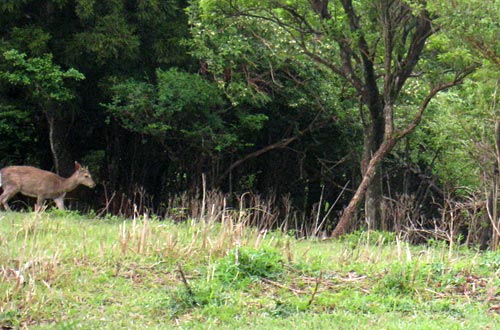
Visitors can see "shika" (deer) almost everywhere in Izu.
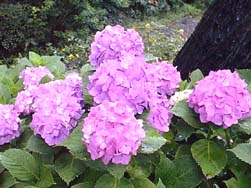
In the mid 1990s we had lots of beautiful hydrangeas, which later dissapeared.
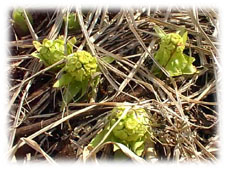
Butterburs also existed next to our house. Their sprouts are available in early spring and tasty. It is understandable that deer are fond of them.
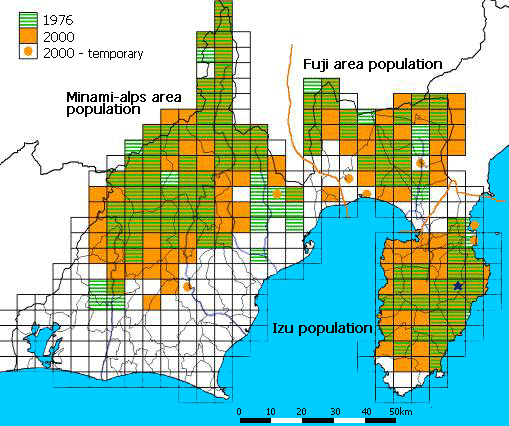
Three deer populations in Shizuoka Prefecture:
The comparison between 1974 and 2000 eloquently endorses the dramatic expansion of the habitat of deer in Shizuoka Prefecture. The blue star points the place of my summer house. (Source: Shizuoka Prefecture)
The comparison between 1974 and 2000 eloquently endorses the dramatic expansion of the habitat of deer in Shizuoka Prefecture. The blue star points the place of my summer house. (Source: Shizuoka Prefecture)
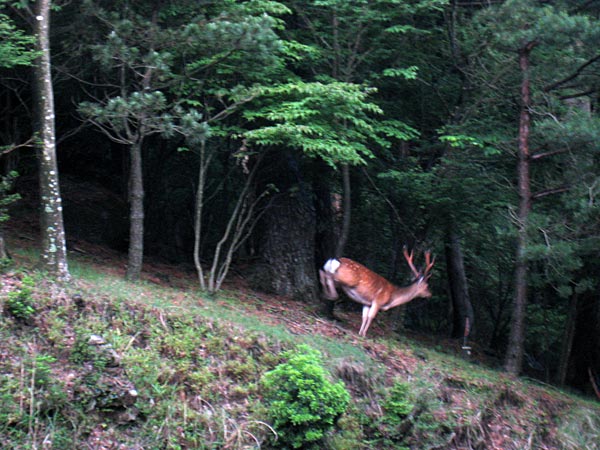
A large stag was running away, when he noticed that I was approaching him. Please check the video to see how he tried to eat tasty leaves.
 Visitors to Izu are fascinated when they encounter "shika" (deer) and other animals while driving in the forest. It is indeed a fascination to see big wild animals at a short distance. However, local residents cannot enjoy the delights to see wild lives in their neighborhood, because among others the number of deer is simply too much in Izu.
Visitors to Izu are fascinated when they encounter "shika" (deer) and other animals while driving in the forest. It is indeed a fascination to see big wild animals at a short distance. However, local residents cannot enjoy the delights to see wild lives in their neighborhood, because among others the number of deer is simply too much in Izu.It is said that deer do not remarkably affect natural vegetation if their population density is less than 3 or 5 per square km and do not badly damage agriculture if their population density is less than 1 or 2 per square km. The research undertaken between 2004 and 2006 shows that the deer population density is averagely 26.5 per square km in Izu as a whole. The East Administration Unit (for deer) including Ito city has even bigger number of 37.3 per square km and the National Forest Administration Unit where I have my summer house has also as much as 33.3 per square km. My summer house administratively belongs to Izu city, where the human population density is 96.8 per square km. This means that there is one wild deer for three humans in Izu city.
When I started to live on a mountainside of the Amagi Mountains at the beginning of 1990s, I rarely saw deer. The nearest deer stock to my house might have existed between Mt. Manjiro and Amagi Highland Golf Course which is located about 5 km distant from my house. I could occasionally see some deer on the fair way while playing golf. But, the number of deer and their living space seemed to have increased drastically since the beginning of this century.
About ten years ago, when I went to Amagi after interval of a few winter months, I was surprised to see most new leaves disappeared or were badly damaged on our hydrangeas, which I had grown from small leaves I plucked from the roadside. A dozen hydrangeas were grown up hgher than 1 m by that time and bore every spring and summer plenty flowers. However, in the following years I had to observe our hydrangeas becoming smaller and weaker and they finally disappeared in around 2003. The same thing happened also to azaleas, forsythias and camellias. They bravely resisted a few years, but became finally destroyed.
I then heard that the damage must be caused by deer and saw many neighbors started to build steel fences around their land to protect their plants. Not only some garden plants were destroyed, but also natural environment changed a lot. A large colony of butterbur was eaten up and bamboo grasses which covered the whole ground surface also disappeared. Some big trees were barked including our dogwood just beside our wooden terrace.
I recently discovered that the damages caused by deer are a big problem for many provincial municipalities in Japan. Deer were recklessly hunted during the course of Japanese industrialization till 1930s. As a result the number of deer decreased, their living space shrunk and their existence became endangered. Therefore protection measures were introduced such as absolute prohibition of hunting does (1947 - 2006) and introduction of hunting quota for stags (1978). Another important factor for deer is the rapid expansion of artificial forest from 5 million ha in 1950 to the present 10 million ha. However, the Japanese deer could successfully adapt to the drastic change of their environment and thanks to the preservation policy of wild life, they increased their number and living space drastically without important predators especially in the last two decades.
Izu in particular has better living conditions for deer with its higher percentage of broadleaf forests and mild climate with negligible snowfall and the deer population has exploded in Izu. This causes heavy damage to agriculture and forestry. Planted trees such as Japanese cedars (sugi) and cypresses (hinoki) are injured. Shiitake mushrooms are eaten and young oak and other trees used for shiitake plantation are damaged. Japanese horseradish (wasabi), rice and fruits are eaten by deer. The damage caused by deer in Izu amounted to be 150 million yen - about 1.6 million $ - in 2007. Moreover the ecological system of forests is badly damaged, because overpopulated deer bark trees and eat up grasses, and certain plant species disappear and the vegetation changes drastically.
Upon the appeal from the local people Shizuoka Prefecture launched the first program to manage deer population in Izu in October 2004. The program finished in March 2008. However, despite of the increased efforts to seize deer, the deer population increased from about 10,000 in 2003 to about 20,000 in 2006. Maybe there was an underestimation of the existing population in 2004 and its growth rate, though the seizure was executed according to the plan (2004-3596, 2005-3962, 2006-4290).
Under the second program which started in April 2008 and will continue till 2012, Shizuoka Prefectures declares a target to decrease the deer population to the optimal density of 1 to 2 per km2 - the absolute number will be between 1,000 and 2,000. This number should be large enough to preserve the specis. - , while a higher quota of 3 to 5 is set for the National Forest Unit where most of the wildlife sanctuary in Izu exists.
Thus, as Shizuoka try to stamp out quite many deer in the coming years. Then, it also has to find reasonable ways to utilize the value of deer as game, meat, skin and antler and so on. However, Japanese people have no tradition of hunting and consumption of game. We traditionally did not have the habit of eating animal meat. Only 150 years ago we started eating pork, beef and chicken, but mutton is still not popular "because it is stinky" and game meat is for most of Japanese people out of question, though many of us know that game is delicatessen in European cuisine. Recently Izu city started a study to create a local specialty using venison. I am skeptical whether they can succeed, but curious about the outcome of their intensive research.